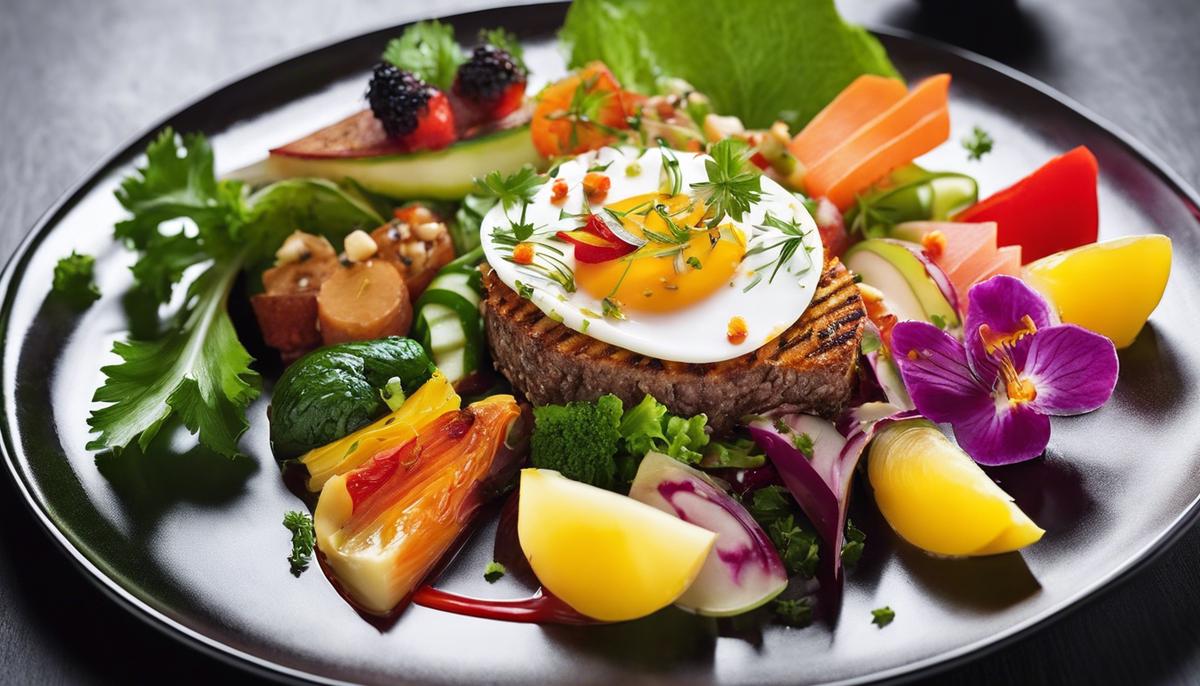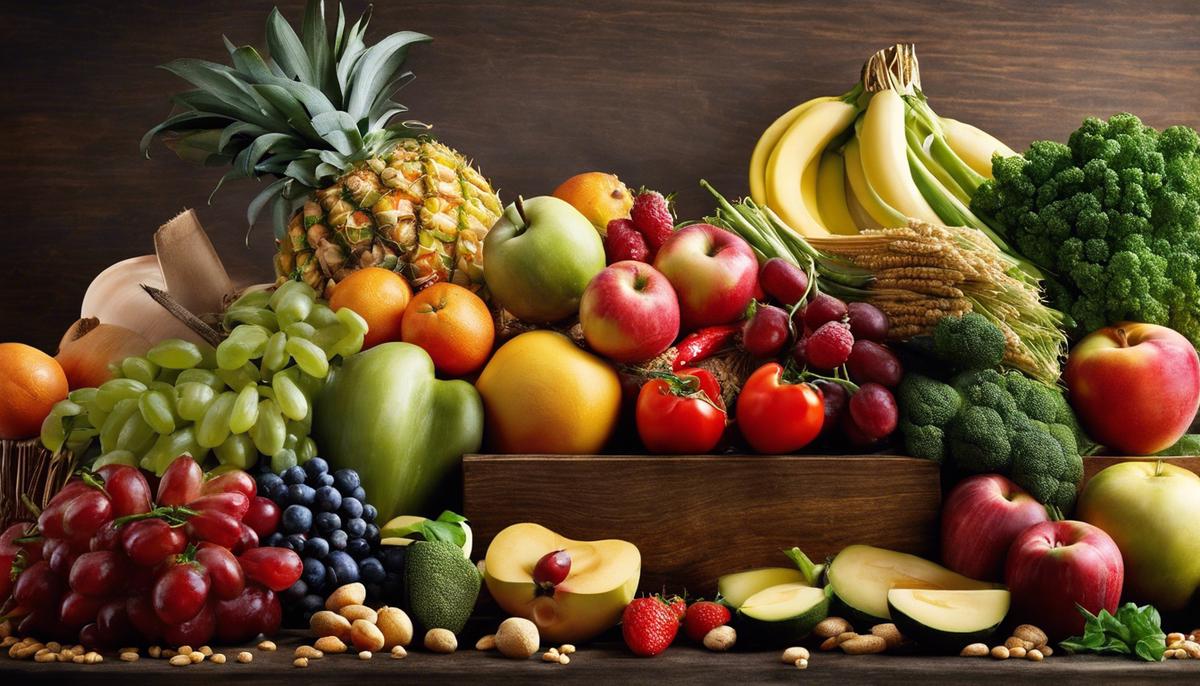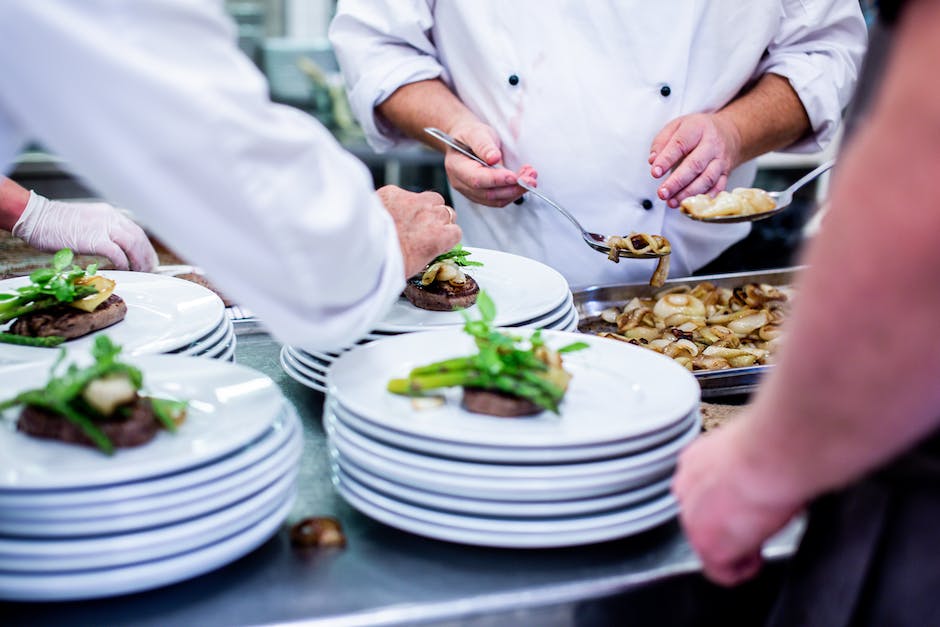

Agridisk
Egypt - Alexandria

Food production industry & What are the types of production in food industry?
Description: In our rapidly evolving world, the journey food undertakes from farm to table has become a complex tapestry weaved by countless hands and innovative technologies. From the amber waves of grain to the vibrant produce section at your local market, each morsel of food tells a story of agriculture, transport, processing, and distribution. As we pull back the husk, we uncover the remarkable balance that must be struck between local farming practices and global supply chains. It is a narrative punctuated by the relentless push for sustainability and the embrace of technological advancements designed to feed a growing population while respecting our planet's finite resources. Ah, the culinary world – a vast universe where every dish tells a story, every ingredient has history, and every bite holds a journey. Have you ever paused between mouthfuls to ponder the voyage behind the vibrant plate of food that tantalizes your taste buds? The true story of our food is an epic saga of transformation, connecting souls and soil across the globe. From the sun-ripened vineyards of the Italian countryside to the bustling spice markets of Morocco, the journey of our food is interwoven with the narratives of farmers, artisans, and purveyors who revere the land and celebrate the harvest. It's an art form—an expression of culture manifesting in flavors and textures. What arrives on our plates is not merely sustenance; it is a chapter of an ongoing narrative, a culinary chronicle that begins long before we set the table. Imagine the journey of a humble tomato, cradled in the hands of a farmer as the morning dew dissipates in the rising sun. This fruit (yes, it's a fruit!) embarks on an odyssey from seedling to harvest, nourished by the soil and cared for by those who toil, until it's plucked in its prime. Transformed through the alchemy of cooking into a robust marina sauce, this single ingredient amalgamates centuries of tradition with a dash of innovation. The globally adored sushi, an artful ensemble that hints at devotion and precision, is another testament. Every sliver of sashimi and carefully molded nigiri speaks of the fisherman's early morning venture into the embracing arms of the ocean, each grain of rice a whisper of the paddy fields' serene ambiance. But let's not forget the unsung heroes of our food odyssey: the local bakers, the cheese makers, and the chocolatiers. They are the magicians crafting bread that sings as it cracks, cheeses that tell tales of pastoral meadows, and chocolates that melt, unveiling layered stories of equatorial farms. When we explore exotic cuisines, we are essentially astronauts on a gastronomic spacewalk, transcending borders with each savory forkful. Whether relishing pho in a Vietnamese alleyway or noshing on tapas in a bustling Spanish plaza, we engage in a universal language that articulates itself through spices, herbs, and ancestral cooking techniques. And as we gather around laden tables with friends, our shared meals become a tapestry of connection, weaving us together in a grand, delectable narrative. Food, after all, is the protagonist that brings people to the same script, regardless of their origins or palates. So, the next time you savor an artichoke's delicate heart or a chocolate's bittersweet farewell, remember that you are sipping from a deep well of tales, traditions, and travels. Whether it's a simple comfort dish or an avant-garde tasting menu, every morsel has traversed a fascinating path to arrive on your plate, inviting you to partake in its epic journey. As a lover of all that is edible, the unwritten chronicle of our food doesn't need a summary, because, for those who live to eat, the story is infinite, with each meal an inviting prelude to the next scrumptious adventure. Bon appétit! Ever ponder how today’s avocado toast might tell tales of technological triumph? Within food production, the digital age simmers with innovation, infusing historic recipes with futuristic flair. Enlightened foodies revel in the fusion of culinary tradition with cutting-edge tech, aware that this blend is reshaping our connection to what we eat. Say hello to precision agriculture. Satellites and drones now waltz across the skies, capturing data that guide farmers with GPS precision. Soil health and crop conditions, once evaluated through toil and guesswork, now submit to the scrutiny of sensors. The result? A bounteous yield caressed by the kiss of technology, ensuring that each vegetable graces the table at its peak of perfection. The laboratory, long a sanctuary of science, now mingles with the kitchen. The introduction of lab-grown meats presents a bold exploration into sustainability. Cultured from a few animal cells, this innovation promises steak enthusiasts their savory fix while taking a gentle step on Earth's resources. Fans of charcuterie rejoice as science serves up a salami sans the sacrifice. In the bakery, the dance between technology and tradition unfolds with robotic grace. Artisanal loaves once handcrafted now see their kneading and shaping artfully executed by machine. The bakers, far from obsolete, orchestrate a symphony of sensors ensuring each crust and crumb resonate with the warmth of their human touch. Cocoa, once nurtured by the hands of master chocolatiers, now swirls through the pipes of 3D printers. Chocolate, a lover of precision, moulds into fantastical shapes previously only dreamt of. The velvety richness remains unchanged, but these bespoke confections capture the imagination in ways traditional methods never could. Aquaculture dives deep into tech with systems that monitor and adjust water conditions, creating a nirvana for finned delicacies. These controlled environments yield seafood with a story that speaks of uninterrupted monitoring and a devotion to the ecosystem. Hidden within our everyday delicacies is a digital tale waiting to be savored. Behind every bite is an algorithm, a sensor, or a piece of code that ensures the journey from farm to fork is not only sustainable but an experience that tantalizes the palate. Rest assured, the essence of food’s story remains unchanged—its power to connect and nourish is timeless. Yet, in this brave new world, the love affair between technology and food production is only just beginning to heat up our passion for the culinary arts. We welcome the revolution with open arms and hungry bellies, ready to feast on the next chapter of food’s epic tale. With every carefully crafted dish or new restaurant opening, there's an underlying narrative that speaks to the pressing issues facing this beloved sector. A sizzling topic on the burner is food waste management. As any epicurean would heartily agree, respect for ingredients starts with their judicious use. Despite the culinary world's creative efforts to use every part of an ingredient, food waste remains a sticky issue, with economic implications that weigh heavily on both producers and consumers. Innovations in preserving methods and the valorization of 'ugly' produce are making strides, but the tug-of-war between reducing waste and maintaining profitability is a delicate balance to manage. On the path from farm to fork, the ethical treatment of workers often remains obscured, yet it's crucial to the plate’s integrity. The hands that harvest, the backs that carry, and the minds that plan deserve a fair wage and safe working conditions. The push for fair trade and ethically sourced ingredients is more than a trend; it's a movement that recognizes the human element of our food chain, demanding economic fairness for those whose labor feeds the masses. The meat of the matter these days is also the alternatives to meat. Plant-based diets are gaining traction, not just for their health benefits, but for their kinder footprint on the planet. Yet, while the growth of this market is promising, it's also challenging the economic landscape of traditional livestock farmers and raising questions about the future of protein. In the buzz of urban beehives and rooftop gardens, the local food movement grows, championing the shortening of supply chains. The economic advantage here is in the potential to reduce transportation costs and spoilage, while supporting smaller-scale producers. However, the feasibility of local food systems on a large scale can be thorny, particularly when considering the array of climates and population densities across regions. Moreover, the surge in technology is reshaping the dining experience, from reservations to meal prep, but it's also cutting into labor opportunities. Automation may bring consistency and efficiency to the table, but it's a dish served with a side of ethical concerns over job displacement. As palates around the globe become increasingly interconnected, so too does the need to consider the global impact of culinary choices. Climate change, for one, has the entire food world breaking a sweat. The agricultural sector must make pivotal decisions to both adapt to and mitigate the effects of a changing planet. The cost? Potentially reimagined menus, where sustainability ranks as high as taste. Every bite is a statement, a choice that extends well beyond the confines of a kitchen or dining room. As gastronomes indulge in the next mouthwatering creation, the hope is to savor not just the flavors but the conscious decisions that brought it there. The journey continues, one ethical and economic fork at a time, crafting a future where the love of food remains a shared passion, served responsibly. How Cultural Delicacies Shape Global Food Production Trends In a world where fusion cuisine garners standing ovations and a humble street food can be the darling of social media overnight, cultural delicacies are the unsung heroes shaping global food production trends. They whisper tales of geography, climate, and tradition into the ears of farmers, producers, and chefs who passionately listen and translate this wisdom into what lands on our plates. Let's delve deeper into some less explored culinary influencers steering the global food scene. Firstly, consider the spice market. It's more than just a stunning mosaic of colors and aromas—it's an economic engine. Saffron from Iran, Turmeric from India, and Cardamom from Guatemala—these aren't just flavor enhancers; their demand determines crop rotations and supports local economies, influencing the agricultural landscape worldwide. Similarly, the appetite for turmeric in the West has recently skyrocketed due to its health benefits, leading to innovations in its cultivation and a surge in its international trade. Secondly, we can't talk trends without mentioning fermentation, a timeless technique making a thunderous comeback. Fermented foods like kimchi, sauerkraut, and kombucha are old-world staples turned modern-day superstars. They're the poster children for gut health and have become mainstays in supermarkets globally. This has prompted manufacturers to scale up production, explore long-forgotten fermentation traditions, and even develop new hybrid products. Next, heirloom varieties are grabbing the spotlight as gastronomes seek out novelty. These venerable produce options, once at the fringes of extinction, are making a comeback. Forgotten apple varieties, ancient grains like farro and amaranth, and heirloom beans are finding their way back into fields as consumers seek out foods with stories and producers rediscover the value in biodiversity. When it comes to protein, cultural delicacies pivot the trend needle here too. The traditional use of offal and lesser-known cuts of meat in dishes like China's braised pork belly, Argentina's asado, or the French pot-au-feu encourages nose-to-tail dining. This practice not only respects the animal by minimizing waste, it also makes economic sense for producers and consumers, lowering costs and driving innovation in meat processing. Lastly, the dining scene can't ignore foraging—a practice deeply rooted in indigenous cultures. Foraging chefs are connecting diners with nature's seasonal bounty and its ephemeral nature, creating a renaissance of wild foods on menus worldwide. This comes with an increased awareness of the fragility of ecosystems, pushing producers and chefs alike to source and use products responsibly. In this cycavalry of culinary delicacies, it's a cyclical feast of influence. As cultural practices inspire global trends, these trends, in turn, affect the next wave of traditional cooking, and so on, ad infinitum. So, while molecular gastronomy and the latest hipster café are the talk of the town, let's not forget the power of the humble dolma or the tangy ceviche that's been reinvented a thousand times before reaching new shores. With each bite of a well-traveled delicacy, we're not only savoring a country's heritage but also shaping the future of food production, one delicious morsel at a time. So, here's to the brave palates that dare to try everything, and the interconnected world that thrives on the flux of cultural gastronomy—it's a smorgasbord that promises to keep plates full and hearts content, sustainably and creatively, for generations to come. Bon appétit! As culinary enthusiasts well know, the dining table is more than a place to satisfy hunger—it's an altar where we commune with the symphony of life. It's about time that altar becomes a beacon for sustainability, an embodiment of the responsibility we all share for nurturing the planet that feeds us. One of the most pivotal steps towards sustainable cuisine is championing heritage grains. These ancient varieties, once commonplace before industrial agriculture homogenized fields with high-yield crops, are making a thunderous comeback. Heritage grains like einkorn wheat, black emmer, and purple barley don't just pack a nutritional wallop and offer new, rich flavors for experimental baking—they're also more tolerant of extreme weather conditions, which strengthens resilience against climate change. The renaissance of forgotten foods extends to vegetables and fruits as well. Root vegetables – from sunchoke to parsnip – once overshadowed by their more famous relatives, bring diversity to the plate and soil alike. Incorporating these into conventional crop rotations can improve soil health, reduce erosion, and decrease reliance on harmful pesticides. Moreover, for those with a palate for the unexplored, these underdogs of the vegetable world provide a canvas for culinary artistry. In the world of proteins, we're observing a quiet revolution. Regional fishery initiatives are championing sustainable practices, ensuring the longevity of marine life while delivering fresher, more flavorful seafood. These programs link arms with restaurants and markets, offering traceable paths from the ocean to the dinner fork, allowing for informed decisions that lead to greener oceans. Furthermore, urban agriculture, once a niche concept, is sprouting rooftops and empty lots in cities worldwide. By embracing vertical farming, hydroponics, and aeroponics, urban centers can reduce their carbon footprint, mitigate the urban heat island effect, and foster a renewed connection between city-dwellers and the source of their nourishment. The buzz of metropolitan life is now harmonizing with the quiet growth of urban greens. And let's not forget our buzzing companions, the bees. Urban beekeeping is sweetening the deal not only with local honey but also by bolstering local ecosystems. From garden to garden, these tireless pollinators aid in growing a diversity of produce that supports a planet-friendly diet, all while adding complex flavor profiles to new and traditional recipes. Lastly, innovation comes full circle as we look to the ancient practice of seed saving – a tradition that allows us to support biodiversity and adaptability in our crops. From a chili pepper that's been a cultural staple for centuries to a rare apple variety with unique tartness, valuing genetic diversity ensures that every seed sown is a rebellion against the encroaching threat of monoculture. With each choice at the grocery store, each ingredient prepped in the kitchen, and every bite savored at the table, we have the power to influence the trajectory of our planet's ecological harmony. As gastronomes, our love affair with flavor has always been deeply personal, and now it's unequivocally global. To embrace sustainability is to feed the future not just with sustenance, but with hope, diversity, and an enduring relish for life. In the epic gastronomic journey of humanity, let sustainability be our north star, guiding us to enlightened consumption and communal well-being. As we digest the multitude of facets that define the food production industry, one truth becomes abundantly clear: the harmony of sustainability, ethical practices, and cultural integrity with technological innovation is not just a lofty ideal, but an attainable goal that steadily shapes the future of our global food systems. The layers of complexity found within food production reflect our diverse communities and the shared aim to foster a resilient, equitable, and nourishing food landscape. Ultimately, the choices and changes we implement today will serve as the ingredients for the sustainable feast that will feed tomorrow's world. When we sit down to relish our meals, rarely do we pause to consider the journey that the food makes to arrive on our plates. This intricate and multi-layered journey involves multiple steps that transform raw natural ingredients into the final products that grace our dinner tables. With the food industry being such a central part of our lives, understanding how it operates not only curbs our curiosity but also enlightens us to make conscientious eating decisions. This fascinating exploration initiates from the basic farming, fishing or animal rearing processes that comprise Primary Food Production. It then moves to Secondary Food Production that constitutes processing and transforming these primary products into consumables. Finally, it revolves around Tertiary Food Production, which deals with the delivery and distribution aspects that bring the consumables to us, the consumers. Delving into the captivating realms of food calls for blended flavors, succulent textures, and an enduring passion for culinary artistry. But where does all this enchanting flurry start from? Indeed, it begins from what we commonly term as "primary production" in the food industry. So grab a cup of coffee, sit back, and relish the taste as we unmask the importance of primary production. Imagine unfolding the marvels of a beautifully baked cake, or the intricate tastes in an exquisitely prepared risotto—before setting off on this delightful culinary journey, it's critical to embark on an exploration of the origins. Primary production can be defined simply as the first step in the food supply chain where raw materials are grown or raised, harvested, and sorted to end up as delightful food products on the dining table. It involves various stages starting from the cultivation of the grains and legumes, rearing the livestock, picking luscious fruits from the orchard, to harvesting vegetables from the fertile fields. Just as an alluring song starts with a delightful melody, the culinary journey ignites with the first step in food production. Undeniably, primary producers play a pivotal role in setting the rhythm! They ensure the food that foodies around the world relish is safe, fresh, and produced responsibly. These passionate farmers & ranchers guarantee that the produce is farmed sustainably, benefitting not just the bellies but also Mother Earth. Venture into any bustling, vibrant farmer's market and feel the spark of excitement! It is here where we often find the fruits of primary production: crisp apples, juicy oranges, fresh eggs, hormone-free chicken, organic vegetables, and grains! Notice how these simple raw products become the stars in our kitchen, going on to become mouth-watering dishes prepared with love and passion. Why does primary production matter so much? Well, imagine taking a bite from a succulent, perfectly cooked steak. The core joy derived from that bite or the wholesome flavors enveloping your senses rely on the quality of the raw meat. If the cow was not raised responsibly, the meat wouldn't give a flavorful steak, right? Similarly, how can a decadent cake come out perfectly if the wheat for the flour wasn't reared sustainably? It all floats down to quality. Excellent primary production ensures you can taste the rainbow, experience different cuisines, and keep the circle of culinary life spinning. Responsible techniques used by the primary producers ensure the food doesn't lose its natural essence but is also ecologically sustainable. All in all, primary production in the food industry serves as the foundation of everything delicious. It's what starts the majestic process from the farm to fork, ensuring the raw products used in your culinary adventures are fresh, safe, nutritious, and have done their bit for nature. Now isn't that food for thought? So, while savoring that succulent piece of steak or gobbling down a chunk of creamy chocolate cake, spare a thought for the primary producers. After all, they initiate this beautiful culinary journey! Uncovering the Magic in Secondary Food Production If the way into our hearts is indeed through our stomachs, then the story of our food has a critical part that's often unseen and unsung, yet vitally significant - secondary food production. Simply put, secondary food processing is the magical transition that turns primary products, those raw and natural ingredients straight from the farm, into the food items that fill our pantries and refrigerators. Picture this - a farmer has just harvested a crop of plump, juicy tomatoes. In primary production, these beauties would find their way into your shopping basket fresh and ripe. But let’s take a trip down the secondary production lane where these tomatoes undergo a transformation and become a savory pasta sauce or tomato ketchup you spread on your hot-dog. It’s in this behind-the-scenes ballet of transformation where the scope and significance of secondary food production lie. Secondary food production, therefore, refers to the second tier of the food industry’s production chain, focusing primarily on processing raw materials into ready-to-eat or ready-to-cook food items. And it’s by no means just an 'optional' step. It's a crucial bridge that allows farm fresh produce to morph into various edible forms that have longer shelf lives and are often more convenient for consumers. But why is this secondary step so important in the food value chain? The answer is simple – variety, convenience, and preservation. Think about the vast array of foods you enjoy daily, from a cheesy pizza to a comforting bowl of vegetable soup, or even the humble loaf of bread – they’re all a result of secondary food production. That's where the wheat becomes flour, milk turns into cheese, and those fresh veggies are transformed into a steamy bisque. On top of that, you get to enjoy your favorite flavors all year round. Those fresh strawberries that feature in your breakfast smoothie on a chilly winter morning? They were likely picked at the peak of ripeness during summer and then made into a preserve. Then there's the aspect of food safety. Secondary food production employs several preservation methods including pasteurization, canning, and freeze-drying that not only keep harmful microorganisms at bay but also prevent the food from spoiling. So, next time you dig into your favorite meal or snack, take a moment to appreciate the culinary journey your food has taken to land on your plate. From the farm to your fork, via the very essential stage of secondary food production, the magic of our meals truly lies in this incredible journey through the food value chain. Enjoy the taste, savor the process! And now that we’ve nibbled on the enticing appetizer that is primary food production and savored the rich entree of secondary production, it’s high time we skipped to the tantalizing dessert – tertiary food production. This simply scrumptious component of the food industry isn’t just the cherry on top, but rather serves as a critical slice in the sumptuous pie that gratifies our gastronomic adventures. Let us sketch out tertiary food production first. It’s essentially the part of the food chain where raw ingredients and products from secondary food production are fantastically fashioned into meals that are served to us. Think about the hustling restaurants frying up your steak, your favorite café dishing out the tastiest frothy cappuccinos or even the frozen pizzas stacked up in the supermarket freezer aisle waiting to be a quick solution to your weeknight dinner dilemma. All of these are examples of tertiary food production, where food is prepared and served! A sizeable part of our foodie adventures root from the explosion of diversity that tertiary food production introduces. It literally adds the seasoning to our meals. Our tastebuds can travel the world in a matter of days – skipping from a spicy Indian curry, swinging to a fragrant Moroccan tagine, and landing on a creamy Italian risotto. Thanks to the art involved in tertiary food production, we have been able to experience such a diverse palette of flavours right from our dining tables. One of the most savory aspects of tertiary food production is how it significantly contributes to the overall economy. Just think about the vast number of people employed in restaurants, cafes, catering services, and food delivery platforms. The list goes on, illustrating how central this stage of food production is to the job market and overall economics. Yet, cookbook magic aside, it’s important to consider the environmental footprint that can be associated with different stages of tertiary food production. From the energy used in cooking and preservation to the waste generated in packaging and transportation, each of these factors contributes to the overall environmental impact of our food system. As responsible consumers, it’s up to us to make choices that support sustainable tertiary production practices. Choosing local eateries that source their ingredients responsibly, or supporting businesses that prioritize minimal packaging, can be our little love letters to the planet. So, consider this, next time you slice into the perfect cheesecake, fork up a bite of a buttery croissant or slurp down a delightful bowl of ramen, tertiary food production has had a hand in that joyous experience. It’s the finale in our food story, taking us from farm to fork, and truly highlights the unspoken heroes –our chefs, bakers, baristas– sprinkling their passion and love for food into every morsel we enjoy. And while the credits may roll on our food's journey at tertiary production, each meal sparks the opening chords of new stories, shared experiences, and connections bonded over the universal language of food. So, let's keep exploring, let's keep tasting, and above all, let's continue celebrating the magic of food in all its forms, right from primary production, through to the finish line of tertiary. After all, it’s this beautiful symphony of processes that creates the cuisine we relish, the experiences we cherish and the memories we treasure. By dissecting each step of food production, from initial harvesting to eventual consumption, it becomes evident that this multifaceted process is an amalgamation of art and science. Recognizing the crucial layers involved in primary, secondary, and tertiary stages adds depth to our appreciation of the comestibles that sustain us. Moreover, this knowledge allows us to become more responsible consumers. As we grow more conscious of the intricate processes and dedicated efforts behind our meals, we can make wiser food choices for not only ourselves but also for our planet.Food production industry & What are the types of production in food industry?
Food production industry
The Journey from Farm to Table | Food production industry
A Culinary Odyssey: Unveiling the True Journey of Our Food

Technological Innovations in Food Production | Food production industry
The Digital Dish: Tech's Tantalizing Impact on Food Production

The Economic and Ethical Aspects of Food Production | Food production industry
Venturing deeper into the kitchen and beyond, the food industry finds itself at a nexus of economic and ethical decisions that could redefine our future plates.

Cultural Influence on Global Food Production | Food production industry

Sustainability and the Future of Food Production | Food production industry
Embracing Sustainability: Seeding the Future at Our Tables

What are the types of production in food industry?
Primary Food Production

Secondary Food Production

Tertiary Food Production
